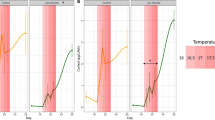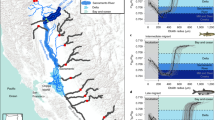Abstract
Many salmon species include males which mature as much as 50% younger and as small as 30% of the adult body size of other males in the population1–8. In the semelparous Pacific salmon Oncorhynchus spp., these small males are known as ‘jacks’, and they compete with larger late-maturing ‘hooknose’ males for opportunity to spawn on the breeding grounds. The existence of jacks is problematical as it is believed that salmon populations should have a single optimal age or size at maturity9–11. I now show, however, that these two alternative life histories are evolutionarily favoured by frequency-dependent disruptive12 selection on the breeding grounds. In coho salmon (Oncorhynchus kisutch), small and large males gain access to females by sneaking and fighting respectively. By contrast, intermediate-sized males are at a competitive disadvantage. Jacks, which are specialized at sneaking, and hooknose males, which are specialized at fighting, have negatively frequency-dependent fitnesses from these alternative breeding tactics. Calculations suggest that the lifetime fitness of jacks is similar to that of hooknose males. Thus, age of maturity in salmon has probably not evolved as a single optimum, but rather as a ‘mixed evolutionarily stable strategy13,14 in which precocious maturity is an evolutionarily viable alternative life history strategy.
This is a preview of subscription content, access via your institution
Access options
Subscribe to this journal
Receive 51 print issues and online access
$199.00 per year
only $3.90 per issue
Buy this article
- Purchase on Springer Link
- Instant access to full article PDF
Prices may be subject to local taxes which are calculated during checkout
Similar content being viewed by others
References
Jones, J. W., The Salmon (Harper, New York, 1959).
Geghards, S. V. Prog. Fish. Cult. 22, 121–123 (1960).
Kimura, S. Jap. J. Ichthyol. 19, 111–119 (1972).
Ricker, W. E. in The Stock Concept in Pacific Salmon (eds Simon, R. C. & Larkin, P. A.) 19–160 (University of British Columbia, Vancouver, 1972).
Hager, R. C. & Noble, R. E. Prog. Fish. Cult. 38, 144–147 (1976).
Schmidt, S. P. & House, E. W. J. Fish. Res. Bd Can. 36, 90–93 (1979).
Jonsson, B. thesis, Univ. Oslo (1981).
Maekawa, K. Jap. J. Ichthyol. 30, 227–234 (1983).
Schaffer, W. M. & Elson, P. F. Ecology. 56, 577–590 (1975).
Schaffer, W. M. Symp. zool. Soc. Lond. 44, 307–326 (1979).
Crandall, R. E. & Stearns, S. C. Theor. Populat. Biol. 21, 11–23 (1982).
Thoday, J. M. Proc. R. Soc. B182, 109–143 (1972).
Maynard Smith, J. Evolution and the Theory of Games (Cambridge University Press, 1982).
Gross, M. R. Z. Tierpsychol. 60, 1–26 (1982).
Schroder, S. L. in Salmon and Trout Migratory Behavior Symp. (eds Brannon, E. L. & Salo, E. O.) 275–285 (School of Fisheries, University of Washington, Seattle, 1982).
Kazakov, R. V. J. Fish. Biol. 18, 1–8 (1981).
Gross, M. R. & Charnov, E. L. Proc. natn. Acad. Sci. U.S.A. 77, 6937–6948 (1980).
Charnov, E. L. The Theory of Sex Allocation (Princeton University Press, 1982).
Charlesworth, B. Evolution in Age-Structured Populations (Cambridge University Press, 1980).
1979–1983 Stock Input Information (Washington State Department of Fisheries, Washington DC, 1984).
Ricker, W. E. Can. J. Fish. aquat. Sci. 38, 1636–1656 (1981).
Bilton, H. T., Alderdice, D. F. & Schnute, J. T. Can. J. Fish. aquat. Sci. 39, 426–447 (1982).
Gross, M. R. in Fish Reproduction: Strategies and Tactics (eds Potts, G. W. & Wootton, R. J.) 55–75 (Academic, London, 1984).
Iwamoto, R. N., Alexander, B. A. & Hershberger, W. K. Salmonid Reproduction, 8 (School of Fisheries, University of Washington, Seattle, 1983).
Slatkin, M. Am. Nat. 114, 384–398 (1979).
Marr, J. C. Stanford Ichthyol. Bull. 2, 157–197 (1943).
Author information
Authors and Affiliations
Rights and permissions
About this article
Cite this article
Gross, M. Disruptive selection for alternative life histories in salmon. Nature 313, 47–48 (1985). https://doi.org/10.1038/313047a0
Received:
Accepted:
Issue Date:
DOI: https://doi.org/10.1038/313047a0
This article is cited by
-
Comparative analysis of animal lifespan
GeroScience (2023)
-
Timing of sneaking behavior in the dusky frillgoby Bathygobius fuscus sneaker males
Environmental Biology of Fishes (2023)
-
Animal life history is shaped by the pace of life and the distribution of age-specific mortality and reproduction
Nature Ecology & Evolution (2019)
-
A quantitative genetic analysis of life-history traits and lifetime reproductive success in reintroduced Chinook salmon
Conservation Genetics (2019)
-
Studying behavioural variation in salmonids from an ecological perspective: observations questions methodological considerations
Reviews in Fish Biology and Fisheries (2018)
Comments
By submitting a comment you agree to abide by our Terms and Community Guidelines. If you find something abusive or that does not comply with our terms or guidelines please flag it as inappropriate.



